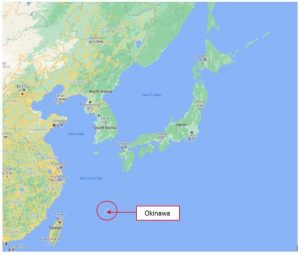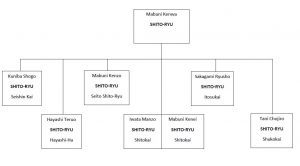At Kansai Karate we like to say we teach traditional karate in a family friendly environment. But what does traditional karate mean?
For us traditional karate is the continuation of teaching karate based on the studies and training of the karate instructors that have taught us with karate as a martial art for self defence. Our karate training and techniques have been developed and evolved over generations.
Kansai Karate teaches a style of karate known as Shito-Ryu Shukokai which means our karate is based on the teaching of Sensei Tani founder of Shukokai Karate, and his teacher Sensei Mabuni founder of Shito-Ryu Karate. Sensei Stephen Kelly had the pleasure of training under Sensei Tani on many occasions and now continues his training under Ishitobi Sensei who ran Sensei Tani’s home dojo.
In this post we are focusing on the history of Shito-Ryu Karate, there will be another post on the history of Shukokai Karate to follow.
Shito-Ryu karate is the name of the karate school founded by Sensei Mabuni Kenwa in Japan. Shito-Ryu is one of the four styles or schools of karate that joined together to form the Japan Karate Federation (JKF). The other styles were Shotokan, Goju-Ryu and Wado-Ryu. These four styles would go onto to influence the development of karate, and in particular sports karate in Japan, and the wider world with the creation of what would eventually become the World Karate Federation.
Brief Summary of Shito-Ryu
- Sensei Mabuni starts karate at age 14 under Itosu Sensei in Okinawa
- At 19 starts training under Higaonna Sensei as well
- Finishes school and becomes a police officer in Okinawa – travels the island learning kata from many karate instructors.
- In 1915 receives certificate of mastership from both his instructors, starts his own dojo at his house the following year.
- In 1925 starts the first full time dojo facility in Okinawa.
- In 1929 moves to Osaka and opens a dojo on the main island of Japan.
- In 1939 Shito-Ryu is recognised as a style of karate by the Butokukai and Mabuni receives his Renshi (Master of Karate).
- Mabuni teaches at schools and universities in an around Osaka in addition to running his dojo.
- Mabuni’s students establish their own schools teaching Shito-Ryu karate and travel around the world taking Shito-Ryu Karate beyond Japan.
Mabuni was born in 1889 in Shuri, Okinawa[i]. He started learning karate at the age of 10 from a member of his father’s household staff[ii]. At the age of 14 he started training under Itosu Sensei in what would later be known as Shuri-te.
At the age of 19 he was introduced to the instructor of his school friend, Miyagi, Higaonna Sensei[iii]. Higaonna taught the style of karate that would go on to be known as Naha-te.
After Mabuni finished school he trained to become a police inspector[iv]. This job allowed him to travel the length of Okinawa and he would often stop in to see local martial arts instructors and learn new techniques and katas from everyone that he met.

Mabuni was a prolific collector of martial arts training and techniques, his son would later say, that he believed Mabuni was afraid that as Japan modernised the old martial arts techniques would be forgotten, and he was frantically trying to collect the knowledge before it was lost[v].
Mabuni would go on to create an Okinawan Karate Study society where he would meet with all his training contemporaries and train and share their techniques together. Members of this group would go on to form some of the best know karate styles around the world today.
In 1915, at the age of 26, he received his diploma of mastership from both of his instructors Itosu Sensei and Higaonna Sensei[vi]. The following year Mabuni started teaching from a dojo at his house. In 1924 he quit his job as a police officer and took up teaching karate at the local school, along with teaching at the police academy. He opened his own dojo in 1925 and had other instructors teaching their styles of karate as well, including Miyagi, Choki, Motobu and Go Kenki[vii].
In 1927 Kano Jigoro, the founder of Judo and a government official connected to the Education Ministry of Japan visited Okinawa as part of the expansion of Judo to the island[viii]. He saw demonstrations from Mabuni and Miyagi and encouraged them to go to mainland Japan to teach karate. In 1929 Mabuni moved to Osaka to open a dojo called Yoshukan and start teaching karate[ix].
In 1938 Mabuni renamed his school Shito-Ryu, which had characters from the names of both of his instructors Itosu and Higaonna[x]. He presented his style to the Butokukai for recognition as a martial arts school in Japan. In 1939 Shito-Ryu was recognised as a karate martial arts school and Sensei Mabuni was recognised as a Master of Karate (Karate Jutsu Renshi)[xi]. The Dai Nippon Butokukai is the national government institution charged with accrediting and certification of all martial arts in Japan.
In addition to teaching at his home dojo in Osaka, Sensei Mabuni took up instructor roles at the Meiji Girls School, and Kansai-Gakuin and Toyo Universities[xii]. He also took over the instructor role at the Doshisha University when his friend and training partner Sensei Miyagi moved back to Okinawa. This is where Sensei Tani started training under Sensei Mabuni, and would go on to create Shukokai Karate based on his training with Mabuni.
Sensei Mabuni combined the teaching styles of both of his main instructors, Itosu Sensei and Higaonna Sensei. Starting his students with the principles of Shuri-te from Itosu Sensei and the Pinan Katas, and advancing into the hard-soft style of Naha-te from Higaonna Sensei.
Source: http://www.rincondeldo.com/caracteristicas-del-estilo-shito-ryu/

Because of his extensive training all over the island of Okinawa he learnt and would go on to teach a great number of different katas, ranging somewhere from 50-60 different katas with different version from different teachers and places in Okinawa. According to Mabuni’s son, some katas he did not teach as part of the Shito-Ryu style, but records are still kept of the vast number of techniques he learnt in his youth travelling the island.
Sensei Mabuni passed away in 1952 at the age of 63.
As Mabuni’s top students progressed and began to master their karate training they would receive recognition of their training and receive a teaching licence or Menkyo. Mabuni would also recognise the name of their own Shito-Ryu style or dojo, for example his student Hayashi would receive the school name Hayashi-ha Shito-Ryu karate. While each student continued the teachings of Sensei Mabuni every instructor infuses their own personality and preferences into the karate they teach.
After Mabuni passed away several Shito-Ryu organisations formed with the lead instructors taking their own path after the passing of their Sensei[xiii]. Mabuni’s son Kenei joined with Iwata to form Shito-Kai, Mabuni’s second son formed Seito Shito-Ryu. Sakagami inherited the the Itosu-ha name and style from Mabuni and formed Itosu-Kai, Tani formed Shito-Ryu Shukokai. Hayashi formed Hayashi-ha, and Kuniba formed Seishin Kai. All of which taught Shito-Ryu style karate. No doubt there are others, but these instructors would go on to form large karate organisations of their own.
Shitoryu Karate Organisations
- Shito-Kai: Mabuni Kenei Sensei & Iwata Manzo Sensei
- Seito Shito-Ryu: Mabuni Kenzo Sensei
- Itosu Kai: Sakagami Ryusho Sensei
- Shito-Ryu Shukokai: Tani Chojiro Sensei
- Hayashi-ha Shito-Ryu: Hayashi Teruo Sensei
- Seishin Kai: Kuniba Shogo Sensei

Shito-Kai would work with instructors of Goju-Kai, Wado-Kai and Shotokan karate styles for form the Japan Karate Federation in 1964[xiv]. With Shito-Kai defining the style of competition karate performed by all Shito-Ryu style competitors across Japan. In 1970 the Japan Karate Federation met with the European Karate Union and worked towards creating the precursor to the World Karate Federation (WKF) which was later recognised by the International Olympic Committee as the peak body for Karate[xv].
Beyond the growth of the Shito-Ryu schools in Japan, Shito-Kai expanded to South America and other parts of Europe and Asia[xvi]. Seito Shito-Ryu, Itosu-Kai and Hayashi-ha all found growth in North America. With one student of Sagakami’s Itosu-Kai – Fumio Demura making his way to California and working as a martial arts consultant in Hollywood, including films like the Karate Kid, Rising Sun & Island of Dr Moreau. Shukokai expanded into Europe, UK and parts of Africa.
Even as the leaders of each of the Shito-Ryu karate organisations have difference is teaching styles and focus, all maintain the teachings of Sensei Mabuni Kenwa with a combination of the Okinawa teaching styles, and a broad collection of katas and techniques from the extensive research and training that he sought from the masters of Okinawa.
[i] https://www.karatedo.co.jp/shitokai/wskf/profile/kenwa_m.html
[ii] http://www.kenshukaidolomiti.it/il-fondatore.html
[iii] https://www.karatedo.co.jp/shitokai/wskf/profile/kenwa_m.html
[iv] Mabuni, Kenei (2012) Empty Hands. p20
[v] Mabuni, Kenei (2012) Empty Hands. p48
[vi] https://www.karatedo.co.jp/shitokai/wskf/profile/kenwa_m.html
[vii] Mabuni, Kenei (2012) Empty Hands. p49
[viii] Mabuni, Kenei (2012) Empty Hands. p50
[ix] https://www.karatedo.co.jp/shitokai/wskf/profile/kenwa_m.html
[x] http://www.kenshukaidolomiti.it/il-fondatore.html
[xi] Mabuni, Kenei (2012) Empty Hands. p54
[xii] Mabuni, Kenei (2012) Empty Hands. p16.
[xiii] Mabuni, Kenei (2012) Empty Hands. p54
[xiv] https://en.wikipedia.org/wiki/Japan_Karate_Federation
[xv] https://en.wikipedia.org/wiki/World_Karate_Federation
[xvi] Fragus, J. (2017) Shito Ryu Masters.
